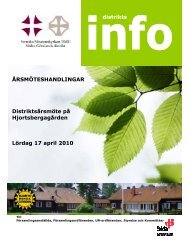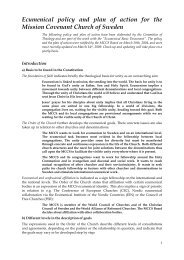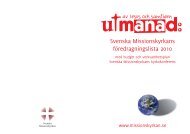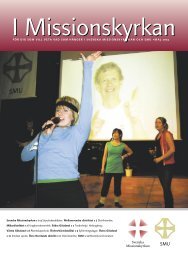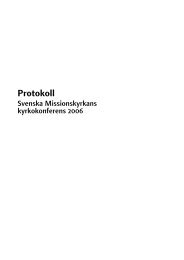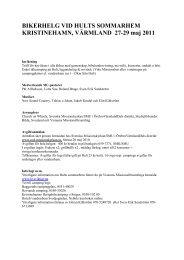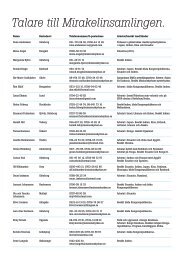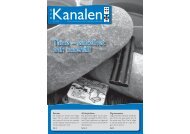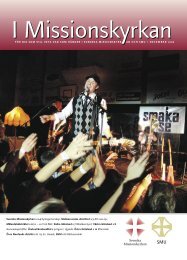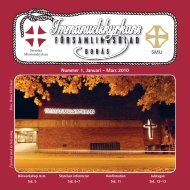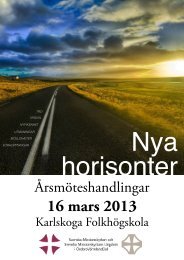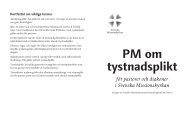Mission and Revolution in Central Asia - Svenska Missionskyrkan
Mission and Revolution in Central Asia - Svenska Missionskyrkan
Mission and Revolution in Central Asia - Svenska Missionskyrkan
You also want an ePaper? Increase the reach of your titles
YUMPU automatically turns print PDFs into web optimized ePapers that Google loves.
Kashgar to Jarkend <strong>in</strong> a carriage along a wonderful road, where the oases were even more<br />
shady <strong>and</strong> lush than the ones <strong>in</strong> the north.” 12 She also mentions meet<strong>in</strong>g the Swedish<br />
missionaries <strong>in</strong> Kashgar <strong>in</strong> the year 1927. As a matter of fact, Mrs. Lattimore <strong>and</strong> her<br />
husb<strong>and</strong>, the great authority on <strong>Asia</strong>, Owen Lattimore, were there on their honey-moon. She<br />
speaks <strong>in</strong> enthusiastic terms of the “happy” bazaars <strong>and</strong> dignified mosques. 13 Owen Lattimore<br />
himself also praises Kashgar, a beautiful <strong>and</strong> <strong>in</strong>terest<strong>in</strong>g town he would not m<strong>in</strong>d see<strong>in</strong>g<br />
twice. 14<br />
The rich summer vegetation of this country was overwhelm<strong>in</strong>g. Billow<strong>in</strong>g fields of corn<br />
reached right up to the lodg<strong>in</strong>gs of the missionaries. Almost every k<strong>in</strong>d of vegetable was<br />
grown, <strong>and</strong> several crops could be harvested three times a year. The most common cereals<br />
were wheat, barley, corn, rice, millet, flax, hemp <strong>and</strong> cotton. And among vegetables carrots,<br />
sugar-beets, radishes, onions, cucumbers, peas, beans, melons <strong>and</strong> water-melons were<br />
mentioned. Fruits <strong>and</strong> berries were also <strong>in</strong> abundance such as mulberries, apricots, nectar<strong>in</strong>es,<br />
cherries, pears, apples <strong>and</strong> grapes, plums, olives, figs <strong>and</strong> pomegranates. 15 Mrs Eleanor<br />
Lattimore makes a note of the fact that she could buy fruits such as melons, apricots <strong>and</strong><br />
“wonderfully juicy nectar<strong>in</strong>es” at nearly every halt<strong>in</strong>g-place. 16<br />
Farm<strong>in</strong>g was done <strong>in</strong> a traditional way. A vital necessity was the water<strong>in</strong>g of the earth. As<br />
has already been po<strong>in</strong>ted out, the ra<strong>in</strong>s were rare dur<strong>in</strong>g the summer months. Dur<strong>in</strong>g the<br />
spr<strong>in</strong>g <strong>and</strong> summer of 1915 for <strong>in</strong>stance when Sir Percy Sykes moved to Kashgar, there was<br />
no ra<strong>in</strong> at all. 17 Spr<strong>in</strong>g ra<strong>in</strong>fall could be quite violent though. Raquette mentions one such<br />
ra<strong>in</strong>fall <strong>in</strong> May, which was so violent that it nearly jeopardized a wedd<strong>in</strong>g-celebration <strong>in</strong><br />
Kashgar. 18 However, as a rule the fields were supplied with water brought down by the great<br />
rivers dur<strong>in</strong>g the melt<strong>in</strong>g away of the snow <strong>in</strong> the mounta<strong>in</strong>s. This water was diverted <strong>in</strong>to<br />
canals, which were later on diversified <strong>in</strong>to ditches <strong>and</strong> grooves. The canals were filled<br />
accord<strong>in</strong>g to a systematic order. Thus the mission stations, for <strong>in</strong>stance, received water <strong>in</strong><br />
their canals on a special day of the week. Dur<strong>in</strong>g the annual autumn ra<strong>in</strong>fall, large bas<strong>in</strong>s were<br />
filled with water at the mission stations <strong>and</strong> elsewhere, a supply which was to last throughout<br />
the w<strong>in</strong>ter. S<strong>in</strong>ce the water supply was so well organized, the country was very productive<br />
<strong>and</strong> poor harvests <strong>and</strong> failures of the crops were rare. 19 Dur<strong>in</strong>g the <strong>Mission</strong> period this country<br />
was even one of the world’s best areas for fruit farm<strong>in</strong>g. 20 From June up to Christmas, people<br />
actually lived almost exclusively off fruit. The American Professor Ellsworth Hunt<strong>in</strong>gton, on<br />
a journey through Eastern Turkestan <strong>in</strong> the early 20th century, predicted a great future for this<br />
<strong>in</strong>terest<strong>in</strong>g area <strong>in</strong> his book The Pulse of <strong>Asia</strong>. He recommended large scale irrigation. He<br />
says that the country was especially suited for cotton crops but also for other crops. 21<br />
Even though flowers were rare, the rest of the vegetation made the country beautiful. The<br />
Norwegian missionary, Otto Torvik, visit<strong>in</strong>g Eastern Turkestan <strong>in</strong> the 1930s, called the area<br />
where the <strong>Mission</strong> was engaged “the country of oases”. He mentions Kashgar <strong>and</strong> Aksu, but<br />
the largest oasis was around Jarkend. 22 In an <strong>in</strong>terview, Ester Johansson, one of the Swedish<br />
missionaries, was once asked what it was like liv<strong>in</strong>g <strong>in</strong> the desert, “We didn't live <strong>in</strong> a desert,<br />
12 Lattimore, 1935, p. 233.<br />
13 Ibid. p. 7 <strong>and</strong> p. 231 f.<br />
14 Lattimore, 1930, p. 316.<br />
15 Högberg, 1925, p. 8. Persson, 1938.<br />
16 Lattimore, 1935, p. 219.<br />
17 Sykes, 1936, p. 239.<br />
18 Ansgarius, 1907, p. 85 f.<br />
19 Torvik, 1946, p. 90.<br />
20 Ekberg, 1948, p. 100.<br />
21 Macartney, 1909.<br />
22 Interview with Ester Johansson, February 27th, 1973.<br />
3



